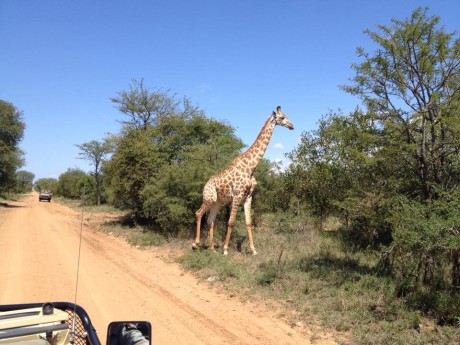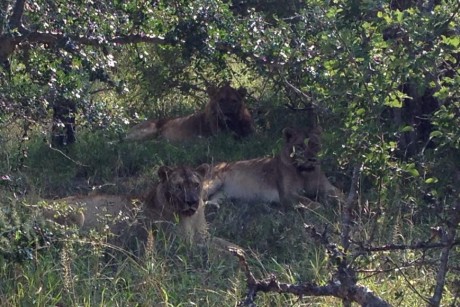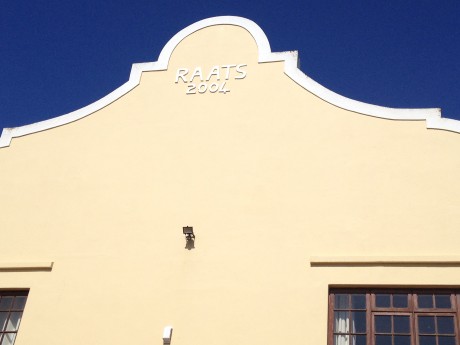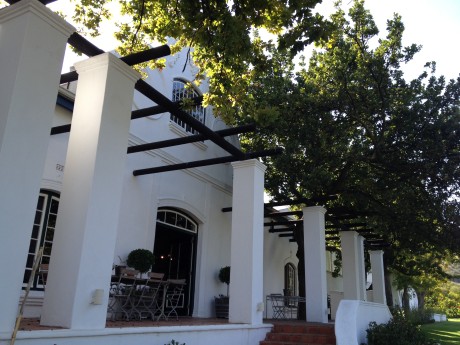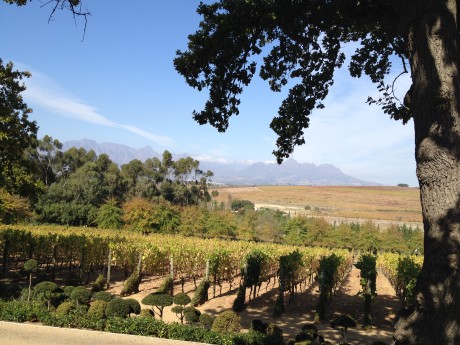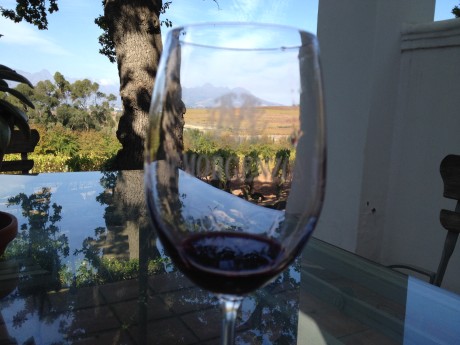Travels in South Africa: Game Reserve, Winery Visits and Pinotage
Today I’ll begin a series of posts detailing my travels in yet another destination in the very wide world of wine-producing regions: South Africa. I’ve enjoyed drinking South African wines for years and studied the region extensively in preparation for my certifications, but nothing could have prepared me for the exquisite beauty of the country, the delicious wines I tasted, and the lovely people that I met along my journey.
When planning this trip, I used many of the same strategies as I did for the adventure in France and Italy in the fall, which meant that I needed a few days of adjustment before diving in to tour Stellenbosch and the Winelands. What better way to spend time adjusting than taking in the spectacular wildlife and nature unique to Africa on a private game reserve?
Prologue: Kapama Southern Camp
I booked two nights at Kapama Southern Camp, a lodge on a private game reserve in the Greater Kruger area. The Kapama reserve is home to the African “Big Five” game (lions, leopards, elephants, rhinoceroses, and buffaloes), in addition to scores of other animals, including giraffes, hippopotamuses, warthogs, impalas, kudus, eagle owls, and many more.
My stay at Southern Camp was a truly once-in-a-lifetime experience. During our game drives, we saw each of the Big Five multiple times, even the elusive leopard, which I saw twice (once on the daytime drive from the airport to the lodge, and then again on our return to the lodge as we were concluding our last evening game drive). I saw elephants pass within a few feet of me, heard lions growl as they fed on a kill of buffalo, and spied rhinos lolling peacefully in their sleep. Our ranger, Garry, was engaging, funny and informative, and our tracker, Stanley, was brilliantly talented in directing us to so many wonderful moments observing animals large and small – including a tiny chameleon disguised as a leaf, 50 yards away, at night, from a moving vehicle! Amazing.
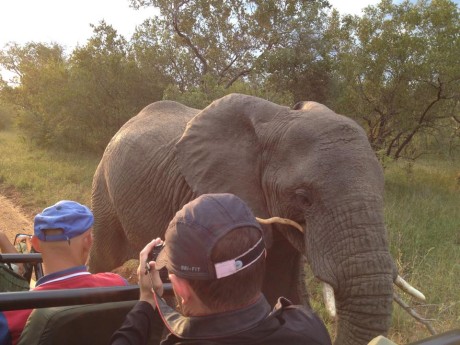
This big guy strolled right by our vehicle. Beautiful, but I have to admit that at the time, I was slightly terrified!
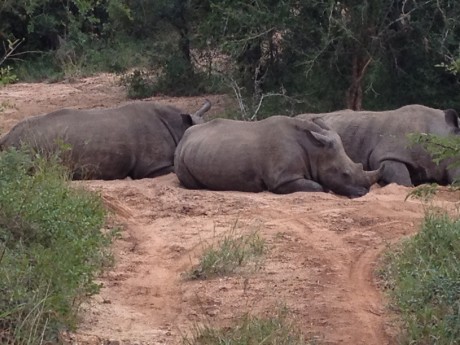
Seven rhinos in the early morning hours, snoozing in a crossroad. I could only fit 3 of them into the frame!
The food, wine, accommodations and service at Southern Camp were all excellent, and I’d recommend it highly if you are looking for a great experience in the Kruger area. I will definitely return!
From Kruger, I flew directly to Cape Town, rented a car, and then drove (on the left side of the road – a first for me!) from the Cape Town airport to the apartment I’d rented through AirBnB in the center of Stellenbosch. After a good night’s sleep, I was charged up and ready to begin my South African wine adventure!
Raats Family Wines
Raats Family Wines was at the top of my “must-visit” list. Several years ago, I attended a fun wine dinner with friends in Austin which featured the wines from Raats, and met the delightful winemaker, Bruwer Raats. Raats specializes in the production of wine from two grapes: Chenin Blanc and Cabernet Franc. Chenin Blanc is the most widely planted grape variety in South Africa, so it’s not surprising that Raats would specialize in it, but Cabernet Franc as a single-varietal specialization anywhere – let alone South Africa – is rare. (Cabernet Franc is normally only found in blends, specifically in Bordeaux and Bordeaux-style blends.)
As luck would have it, Bruwer (who usually hosts all tastings personally) had departed only a few days prior on his annual tour of the U.S., so we may have passed each other in the sky. I tasted five Raats wines: 2014 Original Chenin Blanc (unwooded), 2013 Old Vine Chenin Blanc, 2013 Dolomite Cabernet Franc, 2013 Red Jasper (a Bordeaux-style blend), and 2012 Family Cabernet Franc (the farm’s flagship wine, and the wine that enchanted me at that wine dinner so many years ago).
My two favorites were the Old Vine Chenin Blanc and the Family Cabernet Franc, which was as lovely as I’d remembered. I purchased a bottle of each to accompany me back to Texas.
De Morgenzon
Next on the list was De Morgenzon, which produces one of my favorite wines to sip during hot summers in Central Texas: the DMZ Cabernet Sauvignon Rosé. It’s light, refreshing, and delicious…and at around $10 a bottle at Costco, an excellent value.
The tasting room at De Morgenzon is situated on a gorgeous hillside with breathtaking views, and an impressive flower garden surrounding the tasting room and vineyards. As you walk from the parking lot to the tasting room, the sound of classical music fills the air, as De Morgenzon’s estate vineyards have Baroque music being played over speakers to the vines on a 24/7 basis. (Through his research, DeMorgenzon owner Hylton Applebaum has found that music has a positive impact on the health of the grapevines and ripening of the grapes.)
My tasting host, Melvin, was a knowledgeable guide through the wines he poured for me: 2014 Sauvignon Blanc, 2014 DMZ Chardonnay, 2014 Reserve Chardonnay, 2014 Reserve Chenin Blanc, 2013 DMZ Syrah, 2013 Reserve Syrah, 2011 Maestro. The star of the tasting for me was the Reserve Chenin Blanc. This wine was aged on the lees (i.e., the spent yeast cells which remain after the fermentation process) for 11 months in giant French oak barrels, called foudres. There’s lots of white peach and pear on the nose and palate, with just hints of vanilla and spicy white pepper to make it round, layered and delicious. Score another fantastic bottle for the collection!
The winery I’d planned to visit after De Morgenzon turned out to be closed on Mondays, so (again, per Game Plan Item #3 in my pre-game strategy) I asked Melvin for a few suggestions of wineries that were close by that might be worth visiting that afternoon. He suggested that I stop in to a small winery just down the road for some brilliant wines…including Pinotage.
A Brief Interlude On the Topic of Pinotage
As any good tasting room host in South Africa can tell you, Pinotage is a grape variety which is a cross of the Pinot Noir and Hermitage (otherwise known as Cinsault) grapes, and was created by a professor at Stellenbosch University. Although the grape is planted in other countries, the majority of Pinotage is planted in South Africa. Depending on whom you ask – and where you’re doing the asking – Pinotage is either a unique pride of the South African wine industry, or its most problematic scourge.
South Africa is a new kid on the block as a producer of fine wine for global markets. For political and other reasons, the industry’s track record extends only 20-30 years, and during that time, there was some really terrible Pinotage wine being produced and exported to international markets. During the winemaking process, Pinotage has the tendency to develop a chemical called isoamyl acetate, which can make the wine smell sweet (like bananas – quite undesirable, particularly in a dry red wine)…or like nail polish (ewwww). Unfortunately, this led to South African wines in general – not just Pinotage – being painted (no pun intended) with a broad and negative brush.
The folks I spoke to during my trip appreciate the image problem created by bad Pinotage, and are working hard to produce quality wines – including excellent Pinotage – to increase the standing of South African wines on the global stage. They are also quick to point out that Pinotage represents a small (just over 6%) percentage of overall wine grape plantings in South Africa, and is the third most planted red grape, behind Cabernet Sauvignon and Shiraz/Syrah.
Personally, I tasted some fantastic examples of Pinotage during my travels, and one of the best among them was the winery that Melvin suggested, and which I will describe in my next post: De Waal.
Until next time, get ye to Costco and stock up on the DMZ Cabernet Sauvignon Rosé, because summer is just around the corner. Cheers!

